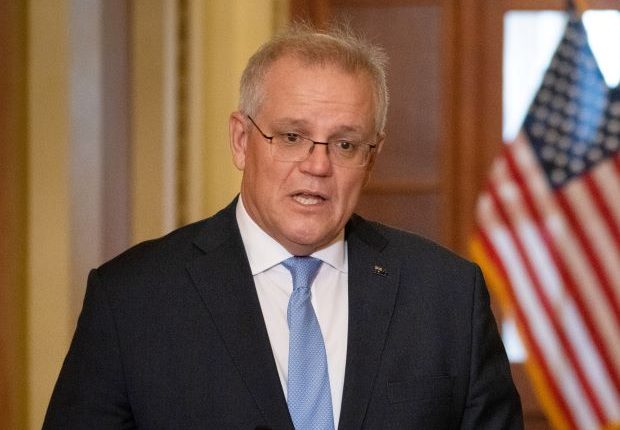The secret powers of an Australian prime minister, now revealed
By Damien Cave
SYDNEY — Most Australians are proud of their Westminster model of parliamentary democracy, in which ministers are empowered to decide how wide swaths of the government operate. Preferring a collaborative politics, they abhor the centralized pomp and power of the US presidency — which is exactly why revelations this week about the country’s Donald Trump-friendly former prime minister have unleashed a volcano of criticism.
Turns out, the blustery leader that Australia chose to evict from office in May, Scott Morrison, had elevated himself to new heights. After COVID arrived in March of 2020, he was not just the prime minister. He swore himself in as a second health minister, finance minister, resources minister and home affairs minister, along with appointing himself co-treasurer. And he kept his new roles a secret from the public and most of his colleagues in Parliament.
“I cannot conceive of the mindset that has created this,” said Anthony Albanese, the current prime minister, who stood before reporters Tuesday (16) to reveal new details about the five jobs Morrison decided he was capable of managing in addition to his own.
“It’s undermined our democracy,” Albanese added.
The baffling arrangement apparently began with Morrison’s realization in 2020 that his government’s declaration of a “human biosecurity emergency” would give the health minister extraordinary powers to direct any citizen in the country to do anything to control the spread of COVID-19. The laws of public health essentially put the health minister above the prime minister.
So, according to a new book excerpted in the newspaper The Australian, Morrison and the country’s attorney general, Christian Porter, came up with an administrative workaround. Finding there was no constitutional block on having two ministers in charge of the same portfolio, Morrison promptly appointed himself health minister, then finance minister, to make sure he could also have a say over emergency spending.
On Tuesday, amid rising calls for him to resign his parliamentary seat, Morrison said his power play had been the “right decision” for “very unconventional times”.
Less clear was why in the 14 months that followed COVID’s arrival, he added more responsibilities. But one anecdote offers a hint: Before the election in May, he used his new ministerial powers to overrule the resources minister, Keith Pitt, on a contentious gas project, killing it off over concerns that it could hurt his party’s chances at the polls.
“This was the only matter I involved myself directly with in this or any other department,” Morrison said in a statement Tuesday, apologizing “for any offense to my colleagues”.
What hurt Australians most, perhaps, was the gut punch of what Albanese called “government by deception”. Traditionally, prime ministers who want to seize control of a portfolio fire the minister and hire another to follow the party line. In the case of the resources role — as with the other self-appointments — Morrison did not disclose to the public that he had simply given himself an extra lever of control over decision-making.
The governor general, the representative of Queen Elizabeth II, officially Australia’s head of state, also said nothing through the entire period, after providing a rubber-stamp approval of Morrison’s appointments.
Several ministers who were sharing power with Morrison were never told, including the finance minister at the time, Mathias Cormann, who currently serves as secretary-general of the Organization for Economic Cooperation and Development, known as the OECD.
Another senior lawmaker, Karen Andrews, who had served as the minister of home affairs, said she had “no idea” about the move until this week.
On Tuesday, she called for Morrison’s resignation. “There can be no justification for why this was not publicly revealed,” she said.
Many Australians were equally appalled, seeing Morrison’s moves as decidedly Trumpian.
Some analysts argued that the revelations confirmed voters’ suspicions about their recently ousted leader.
“At some point, perhaps several points, between 2019 and 2022, voters turned hard on Morrison,” said Jill Sheppard, a political scientist at the Australian National University. “While this decision by Morrison to massively undermine parliamentary convention and even arguably the Constitution was kept quiet, to me this shows how well Australian voters can smell a rat.”
As evidence, she cited post-election surveys of voters showing that more than any policy or issue, disdain for Morrison — who was often described by voters as dishonest — cost his coalition the election.
And the current prime minister, Albanese, seemed eager to hammer the point home. On Tuesday, three months after taking office, he described the previous government’s moves as an “unprecedented trashing of our democracy”.
Jason Bosland, a professor at Melbourne Law School, noted that the trouble went beyond Morrison to the way Australian government works. The Westminster system may require shared responsibility, but it does not prioritize information sharing for public oversight.
“We have a lack of legal mechanisms for accountability and transparency embedded in the law,” Bosland said. “And we have a growing culture of secrecy in government.”
Albanese was asked repeatedly by reporters Tuesday what he planned to do about the systemic issues that Morrison’s actions seemed to reveal. Transparency problems have been getting worse for years, with the prosecution of whistleblowers, raids on journalists’ homes, suppression orders that keep court proceedings private, and a persistent rejection of public records requests.
The prime minister had little to say about that. “We will get proper advice, then we will have proper deliberations,” he said, without committing to legislation. “We are going to run a proper government.”
-New York Times



Comments are closed, but trackbacks and pingbacks are open.